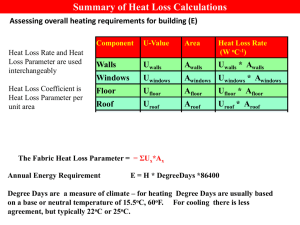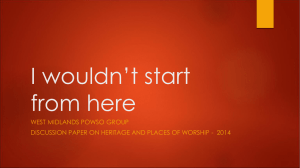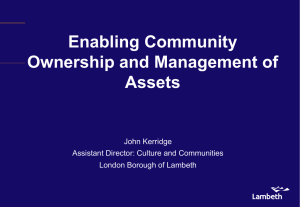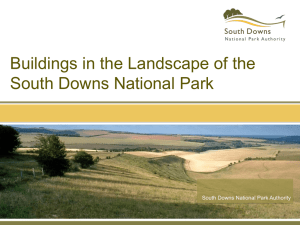Sustainable Design and Climate - Terri Meyer Boake | School of
advertisement
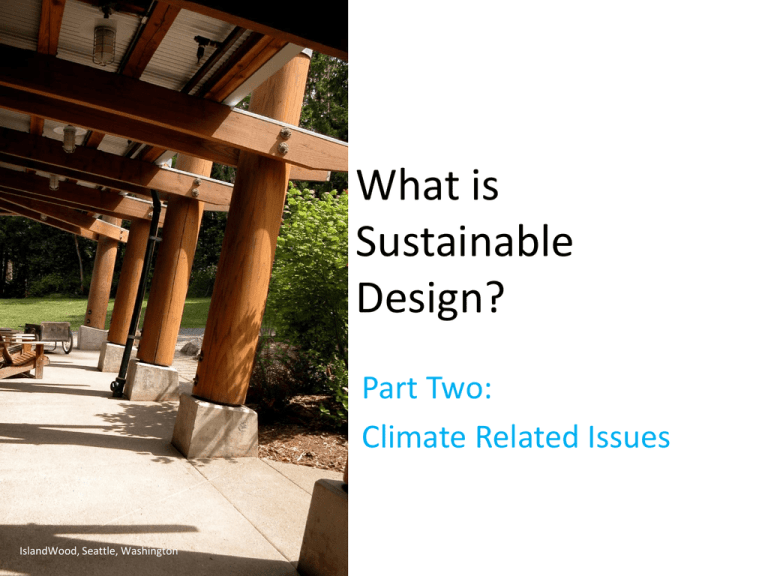
What is Sustainable Design? Part Two: Climate Related Issues IslandWood, Seattle, Washington Presentation Summary In this presentation, we will discuss: • Climate issues • The Importance of the geographic region • Climate Zones of North America • Climate Zones of Canada • The 4 primary bioclimatic building types • Comfort Zone • Microclimate Presentation Credits • This presentation was prepared by Terri Meyer Boake, BES, BArch, MArch, LEED AP • Associate Director School of Architecture University of Waterloo • Past President of the Society of Building Science Educators Buildings and Climate • Climate varies around the globe and indigenous architecture used to respond to climate • 20th century buildings became exclusively dependent on mechanical systems to heat and cool buildings • International Style Architecture, characterized by sealed buildings, tried to create an architectural style that ignored climate • This has resulted in a proliferation of architecture that does not properly respond to its climate • Such buildings now account for between 40% and 70% of energy use in North America – and this cannot be sustained given Climate Change (GHG) and fossil fuel shortages • This lesson will examine how to reconnect issues of local climate and building design Weather and Climate: The weather of the world varies by location as relates to the distance from the equator and as influenced by aspects of geography such as the trade winds, adjacency to bodies of water, elevation, etc. The earth’s atmosphere helps to moderate the climate to prevent radical shifts in temperature from season to season and day to night. The Sun The impact of the sun on our buildings is a direct result of our distance from the equator. This affects amounts of solar radiation as well as solar geometry. Environmental Moderator: A building’s primary function is to provide shelter from the elements, as a function of CLIMATE. To function as a moderator of the environment and to satisfy all other requirements, a building envelope must provide control of: 1. heat flow 2. air flow 3. movement of water as vapour and as liquid 4. solar and other radiation Urban Ecology Centre, Milwaukee Building envelopes are like balloons… Rose Planetarium, NYC Modern building envelopes are like balloons… very thin but their performance is therefore even more critical! Technique vs. Technology Old stone buildings relied on their massive nature to withstand the weather. New buildings are comprised of thinner layers, that are individually less able to withstand the elements. TRADITIONAL METHODS BUILDING SCIENCE These buildings also have “thin skins”. But nowadays, people expect an awful lot MORE PERFORMANCE from their buildings – as technological symbols and cultural icons. Shelter is just not enough. Channel 4 News, London, Richard Rogers Greater London Authority, Norman Foster High Performance Buildings Bio-climatic Design: Design must first acknowledge regional, local and microclimate impacts on the building and site. COLD TEMPERATE HOT-ARID HOT-HUMID Image: 1963 “Design With Climate”, Victor Olgyay. Different climates around the world Image source: Design with Climate. Victor Olgyay, 1963. The climate regions of Canada Even within Canada, there exist variations in climate, enough to require very different envelope design practices and regulations. This mostly concerns insulation and water penetration, as well as humidity concerns. Heating and Cooling Degree Days This map shows the annual sum of heating degree days (an indicator of building heating needs). Data for period 1941 to 1970. Determine if the climate is heating or cooling dominated …this will set out your primary strategy. Cold Climate Cathedrals Buttressing systems in stone allowed for the enlargement of glazing systems that were once hindered by the limitations of the wall – giving more light and heat to the interior of cold, draughty cathedrals. Notre Dame Cathedral, Paris Hot Climate Cathedrals: Gothic cathedrals in hot climates did not use buttress systems to increase their window areas as they did not want more windows to allow heat into the buildings. Santa Maria del Fiore, Florence Traditional hot climate design: In hot dry (arid) climates windows are kept to a minimum to prevent the sun from entering the building. Bright stucco finishes are used to reflect light and keep the environment bright. Courtyard buildings: Courtyards are used in hot arid climates and work well because sun can warm these spaces in cooler months. Courtyards do NOT work well in cold climates because of low winter sun angles. …designing for a cold climate… Designing for a cold climate requires a completely different approach to design and respect for the weather. Buildings must be designed with an environmental barrier. Buildings must be more concerned with their “heating season” than their “cooling season” Traditional cold climate design: At this time heating costs were low, nobody was concerned about CO2 emissions and global warming, so fossil fuels were burned. Traditional cold climate design in Canada took to task the shedding of snow from roofs and used minimal windows in the walls to try to keep heat inside the building. The Comfort Zone The Comfort Zone refers to the range of temperature conditions of air movement, humidity and exposure to direct sunlight, under which a moderately clothed human feels “comfortable”. This will be different for Indoor versus Outdoor conditions. These will be different for different CLIMATE types. This will be different for different cultures combined with climate conditions - what are people used to?? As Architects we use our buildings to not only create comfortable indoor environments, but also pleasing and useful spaces outside of our buildings. There exists a RANGE of comfort that we need to design within. REDUCING OPERATING ENERGY Designing to the Comfort Zone vs. Comfort Point: This famous illustration is taken from “Design with Climate”, by Victor Olgyay, published in 1963. This is the finite point of expected comfort for 100% mechanical heating and cooling. To achieve CN, we must work within the broader area AND DECREASE the “line” to 18C – point of calculation of heating degree days. Passive Bio-climatic Design: Reassessing the Comfort Zone Comfort expectations may have to be reassessed to allow for the wider “zone” that is characteristic of buildings that are not exclusively controlled via mechanical systems. Creation of new “buffer spaces” to make a hierarchy of comfort levels within buildings. Require higher occupant involvement to adjust the building to modify the temperature and air flow. Computer Science Building, York University, Toronto Microclimate When we design WITH the specific local environmental characteristics in mind, we start to manipulate the relationship between the climate, the site and the building to create a local environment or MICROCLIMATE around the building. This “mini climate” that is created around the building can decrease the apparent severity of the climate (and hence the work the building must do to make for a comfortable interior AND exterior environment around the building) OR, if badly handled, can increase the severity of the local climate. St. Thomas University, Houston …this does not belong here… Basic understanding of the 4 climate design zones tells us that certain building types obviously do not belong in certain places... …but there are more aspects to consider... Source: Leonard Bachman, University of Houston The Multivariate Condition Site Bio-Configuration Whatever the FOUND condition of the site upon which we are to consider building has a climate that is not only dependent upon the general climate of the REGION, but also, the specific climate of the site as affected by: •the surface or surfaces that cover the ground •available tree cover, size, height, biodiversity, species, etc. •nearness to water •amount of paving adjacent •height of adjacent buildings Institute of Contemporary Art, Boston Original condition Hot Arid Site Hot Humid Site The building might be the same but the site/climate/microclimate conditions will drastically impact the success of the comfort experienced by the occupants. Temperate Site Cold Site Urban Heat Island Effect Downtown Houston Whether you are sited in a city or suburban space makes a difference. Access to green space can keep the building cool. The “urban heat island effect” is caused by too much building, hot roofs, pavement, (aka thermal mass) and not enough greenery in cities. Tree cover is also important to keep the sun off of paved areas. The microclimate in urban centres can be very different from more natural sites. Buildings and Climate HOT-HUMID HOT-ARID TEMPERATE COLD Buildings MUST be designed to fit in with their CLIMATE. Different climate zones demand different architectural responses in order to function properly and be energy and environmentally efficient. Bio-climatic Design: COLD Where winter is the dominant season and concerns for conserving heat predominate all other concerns. Heating degree days greatly exceed cooling degree days. RULES: - First INSULATE - exceed CODE requirements (DOUBLE??) - minimize infiltration (build tight to reduce air changes) - Then INSOLATE and fenestrate for DIRECT GAIN - ORIENT AND SITE THE BUILDING PROPERLY FOR THE SUN - maximize south facing windows for easier control - apply THERMAL MASS inside the building envelope to store the FREE SOLAR HEAT - create a sheltered MICROCLIMATE to make it LESS cold YMCA Environmental Learning Centre, Paradise Lake, Ontario Bio-climatic Design: HOT-ARID Where very high summer temperatures with great fluctuation predominate with dry conditions throughout the year. Cooling degrees days greatly exceed heating degree days. RULES: - Solar avoidance : keep DIRECT SOLAR GAIN out of the building - avoid daytime ventilation - promote nighttime flushing with cool evening air - achieve daylighting by reflectance and use of LIGHT Traditional House in Egypt non-heat absorbing colours - create a cooler MICROCLIMATE by using light / lightweight materials - respect the DIURNAL CYCLE - use heavy mass for walls and DO NOT INSULATE Bio-climatic Design: HOT-HUMID Where warm to hot stable conditions predominate with high humidity throughout the year. Cooling degrees days greatly exceed heating degree days. RULES: - SOLAR AVOIDANCE : large roofs with overhangs that shade walls and to allow windows open at all times - PROMOTE VENTILATION - USE LIGHTWEIGHT MATERIALS that do not hold heat and that will not promote condensation and dampness (mold/mildew) - eliminate basements and concrete - use STACK EFFECT to ventilate through high spaces - use of COURTYARDS and semi-enclosed outside spaces - use WATER FEATURES for cooling House in Seaside, Florida Bio-climatic Design: TEMPERATE The summers are hot and humid, and the winters are cold. In much of the region the topography is generally flat, allowing cold winter winds to come in form the northwest and cool summer breezes to flow in from the southwest. The four seasons are almost equally long. RULES: - BALANCE strategies between COLD and HOTHUMID - maximize flexibility in order to be able to modify the envelope for varying climatic conditions - understand the natural benefits of SOLAR ANGLES that shade during the warm months and allow for heating during the cool months IslandWood Residence, Seattle, WA Presentation Summary In this presentation, we discussed: • Climate issues • The Importance of the geographic region • Climate Zones of North America • Climate Zones of Canada • The 4 primary bioclimatic building types • Microclimate • Comfort Zone


